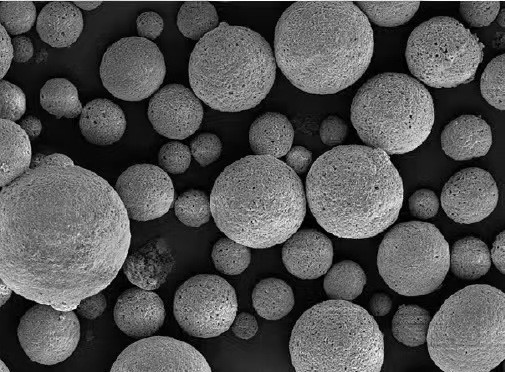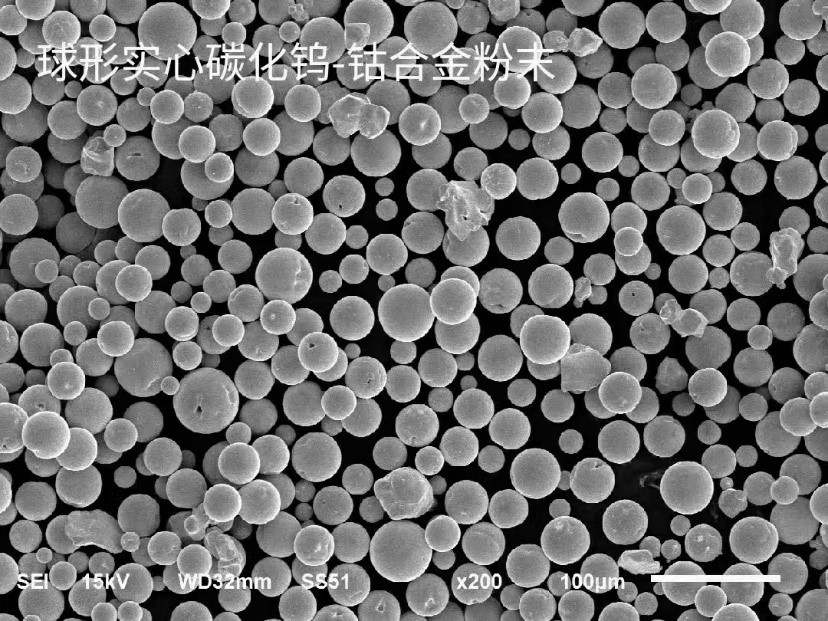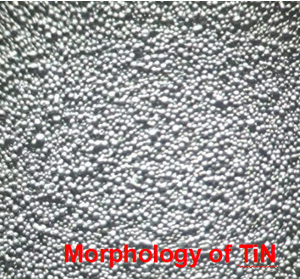Hartmetall-Pulver
Karbidpulver hat aufgrund seiner hohen Härte eine hohe Erosions-, Gleit- und Reibungsverschleißfestigkeit für Anwendungen unter 1000°F. Es ist eine gute Wahl für verschleißfeste thermische Spritzbeschichtung Anwendung.
Schnelle Lieferung
Hohe Sphärizität
Hohe Qualität
Kleines MOQ
Dieses Produkt teilen
Beschreibung des Produkts
Karbidpulver hat aufgrund seiner hohen Härte eine hohe Erosions-, Gleit- und Reibungsverschleißfestigkeit für Anwendungen unter 1000°F. Es ist eine gute Wahl für verschleißfeste thermische Spritzbeschichtung Anwendung.
Es kann für Flugzeugklappenbahnen, Kompensatoren, Kompressorstatoren, Kompressor-Luftdichtungen, Laufräder, Wellen, Abluftventilatoren, landwirtschaftliche Schneidwerke, Pumpengehäuse usw. verwendet werden.
Echte Hartmetallpulver umfassen reines WC, WC-Co, WC-Ni, WC-Co-Cr, WC-Co-CrNi, WC-Ni-Cr, WC-CrC-Ni, WC-WB-Co, WC-Ni60(NiCrBSi), WC-Ni50, WC-Ni-Ni60, WC-Co-Ni60, Cr3C2-10NiCr, Cr3C2-WC-NiCr, TiC, SiC, AlN, WC-TiC-TaC usw.
Hartmetallpulver können durch Sintern und Zerkleinern oder durch Agglomerations-Sintern hergestellt werden, und zwar sowohl für nicht kugelförmige als auch für kugelförmige Pulver.
Bei der Auswahl eines Karbidpulvers sind die Partikelgröße und -form sowie die Art des Karbids wichtig für die Bestimmung des richtigen Materials zur Bekämpfung verschiedener Formen von Erosion, Abrieb und Verschleiß. Die Menge der Metallmatrix in der Beschichtung (Nickel, Kobalt oder Legierung) hängt von der erforderlichen Zähigkeit und Abriebfestigkeit ab.
Nachfolgend finden Sie einen Katalog mit den gängigen Hartmetallpulvern von Truer.
| Truer Hartmetall-Pulver | ||
| Produktionsverfahren: Zerkleinerung, Agglomeration oder Gemisch Partikelgröße: 5-25, 10-38, 15-45, 15-53, 45-106, 53-150um oder individuell Form: kugelförmig für den Agglomerationsprozess; nicht kugelförmig für den Zerkleinerungsprozess |
||
| Pulversorte | Chemische Zusammensetzung (wt%) | Prozess |
| WC | WC 99,0 Min., O<0,1, Fe<0,5 | Zerkleinerung oder Agglomeration |
| WC-6Co | WC Bal., Co 5,0-7,0, O<0,1, Fe<0,5 | Zerkleinerung oder Agglomeration |
| WC-6Ni | WC Bal., Ni 5,0-7,0, O<0,1, Fe<0,5 | Zerkleinerung oder Agglomeration |
| WC-10Co | WC Bal., Co 9,0-11,0, O<0,1, Fe<0,5 | Zerkleinerung oder Agglomeration |
| WC-10Ni | WC Bal., Ni 9,0-11,0, O<0,1, Fe<0,5 | Zerkleinerung oder Agglomeration |
| WC-12Co | WC Bal., Co 11,0-13,0, O<0,1, Fe<0,5 | Zerkleinerung oder Agglomeration |
| WC-12Ni | WC Bal., Ni 11,0-13,0, O<0,1, Fe<0,5 | Zerkleinerung oder Agglomeration |
| WC-17Co | WC Bal., Co 16,0-18,0, O<0,1, Fe<0,5 | Zerkleinerung oder Agglomeration |
| WC-17Ni | WC Bal., Ni 16,0-18,0, O<0,1, Fe<0,5 | Zerkleinerung oder Agglomeration |
| WC-25Co | WC Bal., Co 24,0-26,0, O<0,1, Fe<0,5 | Zerkleinerung oder Agglomeration |
| WC-10Co-4Cr | WC Bal., Co 9,0-11,0, Cr 3,5-4,5, O<0,1, Fe<0,5 | Zerkleinerung oder Agglomeration |
| WC-9Co-5Cr1Ni | WC Bal., Co 8,0-10,0, Cr 4,0-6,0, Ni 0,8-1,2, O<0,1, Fe<0,5 | Agglomeration |
| WC-10Ni-5Cr | WC Bal., Ni 9,0-11,0, Cr 4,0-6,0, O<0,1, Fe<0,5 | Agglomeration |
| WC-20CrC-7Ni | WC Bal., CrC 19,0-21,0, Ni 6,0-8,0, O<0,1, Fe<0,5 | Agglomeration |
| WC-43CrC-12Ni | WC Bal., CrC 42,0-44,0, Ni 11,0-13,0, O<0,1, Fe<0,5 | Agglomeration |
| WC-20CrC-10NiMo | WC Bal., CrC 19,0-21,0, Ni 9,0-11,0, Mo 9,0-11,0, O<0,1, Fe<0,5 | Agglomeration |
| WC-30WB-10Co | WC Bal., WB 29,0-31,0, Co 9,0-11,0, O<0,1, Fe<0,5 | Agglomeration |
| WC-30WB-5CoCr | WC Bal., WB 29,0-31,0, Co 4,0-6,0, Cr 4,0-6,0, O<0,1, Fe<0,5 | Agglomeration |
| WC-50Ni60 | WC Bal., Ni60 49,0-51,0 | Blend |
| WC-65Ni60 | WC Bal., Ni60 64,0-66,0 | Blend |
| WC-75Ni60 | WC Bal., Ni60 74,0-76,0 | Blend |
| WC-80Ni60 | WC Bal., Ni60 79,0-81,0 | Blend |
| WC-85Ni60 | WC Bal., Ni60 84,0-86,0 | Blend |
| WC-90Ni60 | WC Bal., Ni60 89,0-91,0 | Blend |
| WC-95Ni60 | WC Bal., Ni60 94,0-96,0 | Blend |
| WC-65Ni50 | WC Bal., Ni50 64,0-66,0 | Blend |
| WC-85Ni50 | WC Bal., Ni50 84,0-86,0 | Blend |
| WC-90Ni50 | WC Bal., Ni50 89,0-91,0 | Blend |
| WC-Ni-65Ni60 | WC-Ni Bal., Ni60 64,0-66,0 | Blend |
| WC-Ni-50Ni60 | WC-Ni Bal., Ni60 49,0-51,0 | Blend |
| WC-Co-65Ni60 | WC-Ko-Bal., Ni60 64,0-66,0 | Blend |
| WC-Co-50Ni60 | WC-Ko-Bal., Ni60 49,0-51,0 | Blend |
| Cr3C2-10NiCr | Cr Bal., C 9,0-11,0, Ni 6,0-8,0 | Agglomeration |
| Cr3C2-20NiCr | Cr-Bal., C 9,0-11,0, Ni 15,0-17,0 | Agglomeration |
| Cr3C2-25NiCr | Cr Bal., C 9,0-11,0, Ni 18,0-22,0 | Agglomeration |
| Cr3C2-30NiCr | Cr-Bal., C 9,0-11,0, Ni 23,0-26,0 | Agglomeration |
| Cr3C2-WC-NiCr | Kundenspezifisch | Agglomeration |
| Cr3C3-WC-NiCrCo | Kundenspezifisch | Agglomeration |
| TiC | TiC 99,0 Min., O<0,1, Fe<0,5 | Agglomeration |
| TiC | TiC 99,0 Min., O<0,1, Fe<0,5 | Zerkleinern |
| SiC | SiC 99,0 min, O<0,1, Fe<0,5 | Gebunden |
| AlN | AlN 95,0 min, Y2O3 3,0-5,0 | Körnung |
| TiH2 | Ti Bal.,H 3.8-4.0, O 0.2-0.4 | HDH |
| MoS2 | MoS2 98,5 min. | HT-Synthese |
| MnS | Mn 60,0-66,0,S 34,0-36,0 | HT-Synthese |
| Y2O3 | Y2O3 99,9 min. | Agglomeration |
| Al2O3 | Al2O3 99,0 min. | Agglomeration |
| Cr2O3 | Cr2O3 98,0 min. | Zerkleinern |
| TiO2 | TiO2 98,0 min. | Zerkleinerung oder Agglomeration |
| WC-TiC-TaC | W Bal., C 7,5-7,9, Ti 9,9-10,9, Ta 17,5-18,5, O<0,3 | Zerkleinern |
SEM-Foto von TiC durch Agglomeration:

SEM-Foto von WC-Co durch Agglomeration:

Unser Paket:

PREP-System
AM-Pulver
Gesendete Anfrage
Haben Sie Fragen? Senden Sie uns jetzt eine Nachricht! Wir werden Ihre Anfrage mit einem ganzen Team nach Erhalt Ihrer Nachricht bearbeiten.
Ähnliche Produkte
-

Keramikpulver aus Titancarbid (TiC)
Titancarbid (TiC)-Keramikpulver ist ein herausragendes Mitglied der…
-

Keramikpulver aus Titannitrid (TiN)
Titan-Nitrid (TiN)-Keramikpulver wird in der Oberflächentechnik verwendet, …
Anwendungen
Wie wir in der Branche eine Rolle spielen
HIP-Technologie
Beim heißisostatischen Pressen (HIP) wird das Produkt in einen geschlossenen Behälter gegeben, mit Inertgas gefüllt und bei sehr hoher Temperatur (in der Regel nahe der Schmiedetemperatur des Materials) und sehr hohem Druck (in der Regel 100-140 MPa) gesintert oder verdichtet. Auf diese Weise kann das Produkt gesintert oder verdichtet werden.
MIM-Technologie
MIM-Produkte können komplexe Formen aufweisen, präzise Abmessungen haben, eine hohe Festigkeit aufweisen und automatisch in großen Mengen hergestellt werden, wodurch sich die Komplexität und die Kosten der herkömmlichen Metallverarbeitung erheblich verringern lassen.
SLM-Technologie
SLM, auch bekannt als Selective Laser Melting, ähnelt im Prinzip dem SLS, bei dem ein Laser verwendet wird, um Metallpulver in einem bestimmten Bereich zu schmelzen und zu verfestigen, das dann in einem schichtweisen Stapel geformt wird.
EBM-Technik
Elektronenstrahlschmelzen bezeichnet ein Vakuumschmelzverfahren, bei dem die kinetische Energie eines Hochgeschwindigkeits-Elektronenstrahls in Wärme umgewandelt wird, die als Wärmequelle für das Schmelzen von Metallen im Hochvakuum dient. Die Abkürzung lautet EBM.
BELIEBTER DIENST
Unsere professionellen Dienstleistungen
Für die Additive Fertigung
Verschiedene Produkte
Hier bieten wir mehr als 40 hochwertige Pulversorten an.
3D-Druck
SEBM&PREP Technologie und Ausrüstung.
Personalisierung
OEM/ODM akzeptieren
Kein Risiko
Perfektes Layout der Lieferkette
Hohe Qualität
Spitzenumsatz und Qualität
Faire Preise
Hochwertige Produkte zu günstigen Preisen
Anfrage senden
Wir danken Ihnen für Ihr Interesse an unseren Produkten. Wenn Sie eine Anfrage zu einem Angebot oder einer Zusammenarbeit haben, können Sie uns gerne eine Nachricht über das folgende Anfrageformular zukommen lassen. Unser Vertriebsmitarbeiter wird Sie innerhalb von 24 Stunden kontaktieren.

